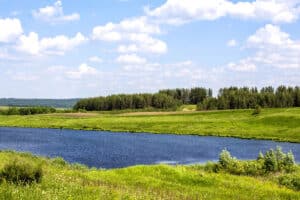When it comes to owning and managing recreational property one thing is certain: every property owner has an opinion (rightfully so) on what’s the best method for improving their land. Although these opinions sometimes rest at opposite ends of the spectrum, a common interest serves as a bond between all recreational landowners – the desire to improve their property. The property might be a ragged clear-cut or the highest turn-key property on the market but one thing is certain – there is a good chance the owner wants to make it better. Often times this motivation is influenced by many factors but one reason that will always make the list is the notion that making improvements to a recreational tract adds value from top to bottom.
Perhaps the best method for adding both tangible and intrinsic value to a recreational tract, implementing appropriate property upgrades can lead to big dividends for an owner at the closing table – especially with current market conditions. Today’s recreational land buyer is seeking out properties that are bargain priced and already have the improvement(s) that are in align with their intended use. These buyers recognize that many landowners made the decision to sell after enduring several years of economic struggles and the direct result is a large supply of improved recreational tracts currently available at a great price. This trend suggests that current sellers, if they haven’t yet, need to implement improvements on their property if they want to be in the game. Depending on the nature of the property and improvements this process can get costly, however, landowners have options available to them in terms of generating income to contribute towards designated improvements.
For many recreational property owners finding the funds to implement property upgrades, not to mention regular maintenance and upkeep, is an ongoing challenge. Anyone who has owned land can attest to the old saying that “there’s always something that needs to be done.” Often times planned improvements must be sacrificed in order to repair existing equipment and structures. This scenario becomes much more common when recreational land is put up for sale with a mindset of: “why waste money improving a property when the plan is to sell?” The reality of this misconception is that although an owner may save money in the short-term by sacrificing appropriate improvements, the long-term outcome is often the following: the property remains on the market for a long period of time and when it sells the price is not what the owner originally hoped to get. In order to overcome the costly process of keeping up with a recreational tract while trying to facilitate the property reaching its full potential owners should get creative in terms of implementing cash flow on a recreational tract. Some creative strategies that could be use to generate cash flow include the following opportunities:
Harvest some timber. Clear-cuts are not the most aesthetic property feature but they serve as great buffers from neighbors and roads and they are phenomenal in terms of wildlife habitat. If you are completely against clear-cutting identify stands where thinning is appropriate. In addition to generating income a thinned timber stands adds aesthetic value and improves the health of the timber stand.
Plant a dove field or a duck impoundment and lease out the hunting rights. Wing shooters will pay to play and having a dove field or duck impoundment on your property will undoubtedly add substantial value to your property. This improvement, which is not always a feasible option, will also improve the chance of a property being sold because of the limited number of properties on the market that offer this recreational pursuit.
Lease out the deer and turkey hunting rights. Insert a clause that the tenants are required to plant and maintain food plots – it will pay off in the event circumstances call for selling the property.
Lease out your empty horse stables. Equestrians are always looking for a place to board their horse – up the ante by permitting them to trail ride on the property.
Lease agricultural fields to a farmer. This method will not only generate cash, it also adds value to your property from a hunter’s standpoint.
Research opportunities for grants at the state and federal levels for funds that might be available or place a conservation easement on your property that will offer annual payments that can be put towards maintenance, upkeep, and improvements. Landowners can negotiate the terms of a conservation easement!
Seek compensation for damages that have been done to your property. This option is a page straight out of T. Boone Pickens’ playbook. Pickens profited from selling ranchland that he had improved from a wildlife habitat standpoint in Roberts County, Texas. He successfully sued a company for $1.5 million that had damaged his property and failed to repair those damages. Pickens action serves as a great example for landowners to follow in terms of standing up for property damages incurred from companies that have a legal right to run heavy equipment on your property. Whether the damage stems from maintaining a utility easement, a logging company conducting a thinning, or a government agency that oversees wetlands, a landowner has a cause of action to ensure his property is not damaged by these activities. Pickens motivation for bringing the lawsuit, which was to repair costly improvements he had implemented on the ranch, reinforces the idea that making wildlife habitat improvements to a recreational property adds value – “Today, I am driven by a desire to conserve and reclaim organized land for quail habitat, and to develop long-term wildlife management plans that can be used to improve land values through an expansion of recreational opportunities.” (T. Boone Pickens, Mesa Vista Ranch, page 3). It’s a safe bet that the $1.5 million awarded to Pickens was spent on additional ranch improvements.
This list is just a few of the more common methods for generating income on recreational land – additional opportunities are endless if you take the time to get creative. Whether your objective is to make the improvements to your recreational property that you’ve always dreamed of or attracting a prospective buyer, there’s no reason to come out of pocket until you’ve looked closely at the assets on your land and the potential income they can produce.
This content may not be used or reproduced in any manner whatsoever, in part or in whole, without written permission of LANDTHINK. Use of this content without permission is a violation of federal copyright law. The articles, posts, comments, opinions and information provided by LANDTHINK are for informational and research purposes only and DOES NOT substitute or coincide with the advice of an attorney, accountant, real estate broker or any other licensed real estate professional. LANDTHINK strongly advises visitors and readers to seek their own professional guidance and advice related to buying, investing in or selling real estate.









Check out the Land Report’s Winter 2011 Edition for more on T. Boone Pickens – a great article by Ray Sasser!
Great article, Rusty! I love the clear examples you provide that many landowners can adopt with little to no capital investment.
On a side note, it looks like that Land Report article on T. Boone Pickens has been inspiring a lot of readers recently! It definitely influenced our Investing in Your Legacy series.
Another creative strategy used to increase ranch value:
World’s First Planting of a Champion Redwood & Sequoia Forest
By all means yes, lease out the hunting rights!
Not only is it beneficial to you there are also so many hunter out there, just like me, always looking for new land to hunt on. In some areas it can actually be pretty difficult to find a place to hunt, although there is tons of land around.
Land owners shouldn’t miss this opportunity.
Thanks for including this topic here Rusty!
Cheers
Sara
Leasing out for hunting is the way to go as more and more people are getting into hunting, the hunting land is becoming scarce. It will benefit both the hunters and the land owner